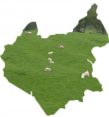GREAT DALBY
Schools in 1818 (population 378 in 1811)
Curate Charles Wildlore reported that there was a school in the parish, supported by subscriptions, but ‘Most of the poorer classes are desirous of the means of instructing their children’.
1833 (population 411 in 1831)
There were four daily schools. Three of these were kept by women and taught 10 boys and 18 girls, whose parents paid for their attendance. The other school had 20 children, mostly boys, and was supported by annual subscriptions of 5 guineas from Sir Francis Burdett (the major landowner in the parish), £1 11s. 6d. from the vicar, Rev Nixon, and £2 6s. from the trustees of the late Mr Bunny.
Anglican schools in 1847
A National School is recorded as having been built on the green in 1840, but which moved to alternative premises in 1844. It received the income from Thomas Bunny’s bequest, which yielded £2 7s. annually and was sufficient to teach four poor children to read. By 1847, Sir Robert Burdett was supporting a day school of 20 boys and 3 girls, linked to the Anglican church, through an annual subscription of £5 and the use of the school house and field. The subscription covered the cost of educating 12 poor children, who attended gratuitously, while the other children paid 4d. per week. It was said that ‘The principal want is a good master’. It is not clear from the records if the children funded by Bunny’s charity and those funded by the Burdett subscription were in the same school. In 1851, Anglican minister W.L. Rollaston reported that ‘We are much in wants of money to support the school’.
Board school
A school board was formed in 1873. In 1876 they built a school house and teacher’s residence with the help of a loan for £1,050; there was no separate classroom for infants. Fees were set at 3d. per week per child for the children of farmers paying £50 rental, 2d. for other children and free for families with more than three children attending. Subjects taught included machine construction and drawing, magnetism and electricity, acoustics, heat and light, general biology and animal physiology. The school was enlarged in 1894 to take 80 children. The average attendance in 1895 was 73.
Sunday schools
None was reported in 1818. In 1833 there was a Sunday school, supported by annual contributions, which was attended by between 50 and 70 children. In 1847, 35 boys and 32 girls attended the Anglican Sunday school, although only 57 were present on the morning of Sunday 30 March 1851. There was also a Wesleyan Sunday school on that date, which met on Sundays mornings and was attended by 67 people. The foundation stone was laid for a new Wesleyan Sunday school in April 1889
LITTLE DALBY
(Population 155 in 1811)
Francis Ellaby left £20 by will, the interest on which was to be used to pay a master to educate two children. It is not clear when the first school was built in the village, but in 1833 it was attended by 16 boys and 15 girls and was partly supported financially by the Hartopp family.
The school was enlarged in 1875 by E.B. Hartopp. In 1895 the average attendance was said to be 12, and it appears to have closed in the early 20th century. In 1916 it was said that the children of the parish attended schools in Great Dalby and Burton Lazars.
Sources
- Education of the Poor Digest, Parl. Papers 1819 (224)
- Education Enquiry, Parl. Papers 1835 (62)
- Charity Enquiry, Parl. Papers 1839 [163]
- National Society for Promoting the Education of the Poor in the Principles of the Established Church, Result of the Returns to the General Inquiry made by the National Society, into the state and progress of schools for the education of the poor … during the years 1846-7, throughout England and Wales (London, 1849).
- 1851 Ecclesiastical census
- Trade directories
- Grantham Journal
